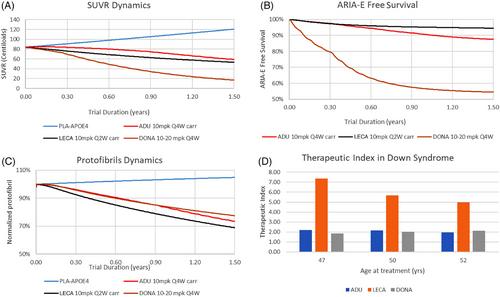Quantitative systems pharmacology-based exploration of relevant anti-amyloid therapy challenges in clinical practice
Abstract
INTRODUCTION
Addressing practical challenges in clinical practice after the recent approvals of amyloid antibodies in Alzheimer's disease (AD) will benefit more patients. However, generating these answers using clinical trials or real-world evidence is not practical, nor feasible.
METHODS
Here we use a Quantitative Systems Pharmacology (QSP) computational model of amyloid aggregation dynamics, well validated with clinical data on biomarkers and amyloid-related imaging abnormality–edema (ARIA-E) liability of six amyloid antibodies in clinical trials to explore various clinical practice challenges.
RESULTS
Treatment duration to reach amyloid negativity ranges from 12 to 44, 16 to 40, and 6 to 20 months for lecanemab, aducanumab, and donanemab, respectively, for baseline central amyloid values between 50 and 200 Centiloids (CL). Changes in plasma cerebrospinal fluid Aβ42 and the plasma Aβ42/ Aβ40 ratio—fluid biomarkers to detect central amyloid negativity—is greater for lecanemab than for aducanumab and donanemab, indicating that these fluid amyloid biomarkers are only suitable for lecanemab. After reaching amyloid negativity an optimal maintenance schedule consists of a 24-month, 48-month and 64-month interval for 10 mg/kg (mpk) lecanemab, 10 mpk aducanumab, and 20 mpk donanemab, respectively, to keep central amyloid negative for 10 years. Cumulative ARIA-E liability could be reduced to almost half by introducing a drug holiday in the first months. For patients experiencing ARIA-E, restarting treatment with a conservative titration strategy resulted in an additional delay ranging between 3 and 4 months (donanemab), 5 months (lecanemab), and up to 7 months (aducanumab) for reaching amyloid negativity, depending upon the timing of the incident. Clinical trial designs for Down syndrome patients suggested the same rank order for central amyloid reduction, but higher ARIA-E liability especially for donanemab, which can be significantly mitigated by adopting a longer titration period.
DISCUSSION
This QSP platform could support clinical practice challenges to optimize real-world treatment paradigms for new and existing amyloid drugs.


 求助内容:
求助内容: 应助结果提醒方式:
应助结果提醒方式:


